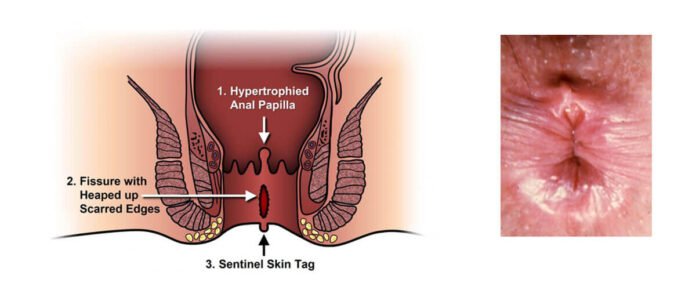An anal fissure is a small breakage in the thin, moist mucosa that lines the anus. It might occur due to constipation or passing hard stools. It causes pain and bleeding during bowel movements along with spasms in the anal sphincter.
It commonly occurs in young infants and can heal completely through proper care and medication. It may occur in adults as well. Most anal fissures are resolved by increasing the fiber intake or taking sitz baths, though in some cases anal fissure surgery is required.
Symptoms of anal fissures:
- Severe pain during bowel movements.
- Pain after passing stool, which persists for several hours.
- Blood in stool.
- A crack in the mucous membrane in the anal area.
- A small lump or skin tag near the anal fissure.
Causes:
- Large or hard stools
- Straining and constipation during the bowel movement
- Chronic diarrhea
- Anal intercourse
- Childbirth
- Anal cancer
- HIV
- TB
- Syphilis
- Crohn’s Disease
Risk factors:
- Constipation
- Childbirth: More common in women after delivery
- Anal intercourse
- Age: It can occur at any age, but is more common in infants and middle-aged people.
Anal fissures are of two types
- Acute anal fissure: Acute anal fissures last for less than six weeks; they are common and heal on their own.
- Chronic anal fissures last longer than six weeks and may require medicine or surgical intervention.
- The surgical option aims to ease the pain and spasms, relax anal sphincter muscles, and allow the fissure to heal. Surgical options include Botulinum toxin and surgical division of an inner part of the anal sphincter. Your surgeon might find the best treatment options for you according to your needs. Both the surgeries are done on the same day as outpatient procedures.
Botulinum Toxin:
Botulinum toxin injection is a minimally invasive procedure for treating chronic anal fissures. The exact efficient dose of the Botulinum Toxin, the number of injections per session, and the injection site are still debatable.
It is an accepted method for the treatment of chronic anal fissures. There is no dose-dependent efficiency; postoperative incontinence rate is not related to the botulinum toxin dosage regardless of the formulation of botulinum neurotoxin used.
The botulinum toxin injection can be given unilaterally or bilaterally into the internal anal sphincter. No difference in healing rate has been observed regarding the site and number of injections per session.
The botulinum toxin treatment is relatively new for anal fissures. It is usually done if other medicines have not helped. Botulinum toxin is safe to use in small doses. The injection of the toxin can be used to paralyze the sphincter muscles. It might prevent muscle spasms, reduce pain, and heal the fissure.
Research studies show that the toxin is helpful for more than half the people who receive it. The procedure is similar to treating GTN ointment and topical calcium channel blockers. The effect lasts for around 2-3 months.
Lateral Sphincterotomy.
Surgery is the last treatment resort for patients with anal fissures. It is considered the most effective treatment. More than 9/10 people experience good long-term results. However, there is an associated risk of complications.
There are several surgical procedures to treat anal fissures. A lateral sphincterotomy involves an incision in the ring of muscle surrounding the sphincter to reduce the tension in the anal canal. It is a short operation, and it does not require an extended stay in the hospital.
It is the most successful and effective treatment for anal fissures. The recovery period is 2-4 weeks. Some may experience a temporary loss of bowel control due to damage to anal muscles. There is mild incontinence associated with flatulence and lasts for a few weeks.
It decreases the pressure inside the anus and increases the blood flow to the area for faster healing. Lateral internal sphincterotomy is performed under anesthesia in the lithotomy position through a circumferential incision placed laterally to the skin outside the anal verge.
The anoderm and inter-sphincteric groove are dissected, and then the sphincter is divided under direct vision. The incision is closed with interrupted sutures.
Advanced Anal Flaps:
The procedure involves taking healthy tissue from another part of the body and using it to repair the fissure and improve the blood supply to the fissure site. It might be used to treat long-term chronic fissures caused by pregnancy or an injury to the anal canal.
Complications:
- An anal fissure that does not heal in eight weeks is considered chronic and requires additional treatment.
- Recurrence: Once you have experienced an anal fissure, you are prone to have another one.
- Extend to surrounding muscles: It may extend to the internal anal sphincter, further complicating the healing.
After The Surgery:
You will need to rest until the effect of anesthesia has worn off. Warm sitz baths are recommended after the surgery to ease the pain and discomfort, especially during bowel movements.
It is recommended to follow up regularly with the doctor to avoid any postoperative complications.
